

JWST Dropped a Picture of Jupiter Science Alert - July 13, 2022

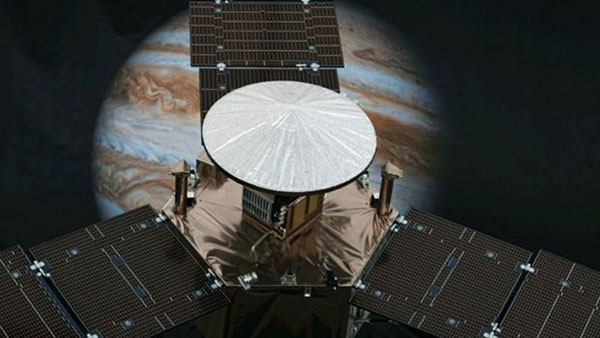
NASA's Juno Spacecraft
Jupiter was formerly twice its current size and had a much stronger magnetic field, study says PhysOrg - May 21, 2025

Understanding Jupiter's early evolution helps illuminate the broader story of how our solar system developed its distinct structure. Jupiter's gravity, often called the "architect" of our solar system, played a critical role in shaping the orbital paths of other planets and sculpting the disk of gas and dust from which they formed.
JWST Captures Jupiter's Auroras 'Fizzing And Popping With Light' Science Alert - May 14, 2025

It's only fitting that Jupiter, nicknamed the king of the planets, wears a crown - and what a crown it is. Although we can't see them with our naked eyes, the giant planet sports the most powerful auroras in the Solar System - permanent shimmering caps at its north and south poles, gleaming in non-visible wavelengths - ultraviolet, infrared, and occasional bursts of X-ray.
Breathtaking New Photos Show Jupiter's Hypnotic Swirling Storms, And How Is This Real? Science Alert - July 29, 2022
Ever since space probe Juno gave us our first incredible views of the poles of Jupiter, the regions have fascinated and mesmerized us. In one of the latest pictures Juno has sent back of the north pole, you can see why: a medley of storm vortices, connected and interconnected, appearing serene from a distance, but raging with an intensity we can only imagine here on Earth.
NASA's Juno reveals dark origins of one of Jupiter's grand light shows PhysOrg - March 17, 2021
New results from the Ultraviolet Spectrograph instrument on NASA's Juno mission reveal for the first time the birth of auroral dawn storms the early morning brightening unique to Jupiter's spectacular aurorae. These immense, transient displays of light occur at both Jovian poles and had previously been observed only by ground-based and Earth-orbiting observatories, notably NASA's Hubble Space Telescope.
Lightning 'Sprites' Have Been Detected on Jupiter For The First Time Live Science - October 29, 2020
![]()
NASA's Juno spacecraft just captured images of colorful bursts of lightning-like electricity high in Jupiter's atmosphere. These phenomena, which include jellyfish-shaped 'sprites' and glowing disks called 'elves', also occur high up in Earth's atmosphere during thunderstorms.
The strange storms on Jupiter PhysOrg - September 28, 2020
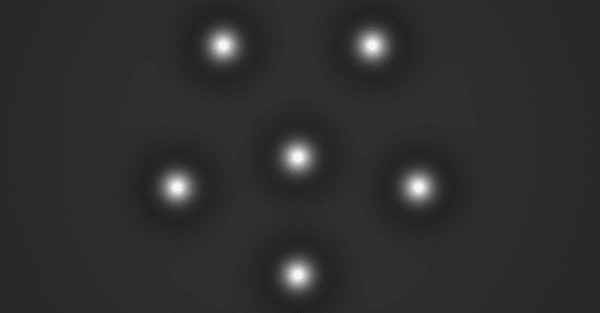
Huge New Storm Creates Hexagon at Jupiter's South Pole Live Science - December 15, 2019
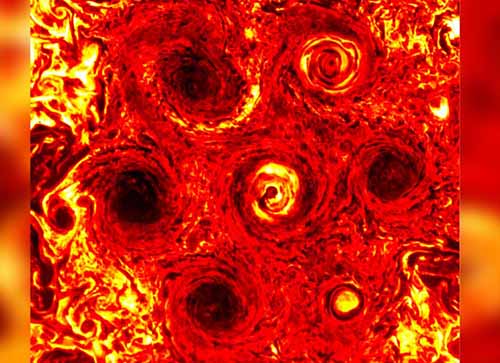
NASA's Juno probe discovered a giant new storm swirling near Jupiter's south pole last month, a few weeks after pulling off a dramatic death-dodging maneuver. Juno spied the newfound maelstrom, which is about as wide as Texas, on Nov. 3, during its most recent close flyby of Jupiter. The storm joins a family of six other cyclones in Jupiter's south polar region, which Juno had spotted on previous passes by the gas giant. (Those encounters also revealed nine cyclones near Jupiter's north pole, by the way.)
Juno solves 39-year old mystery of Jupiter lightning PhysOrg - June 7, 2018

Ever since NASA's Voyager 1 spacecraft flew past Jupiter in March, 1979, scientists have wondered about the origin of Jupiter's lightning. That encounter confirmed the existence of Jovian lightning, which had been theorized for centuries. But when the venerable explorer hurtled by, the data showed that the lightning-associated radio signals didn't match the details of the radio signals produced by lightning here at Earth. In a new paper published in Nature today, scientists from NASA's Juno mission describe the ways in which lightning on Jupiter is actually analogous to Earth's lightning. Although, in some ways, the two types of lightning are polar opposites.
Spectacular aurora lights up Jupiter's North Pole The Guardian - June 30, 2016
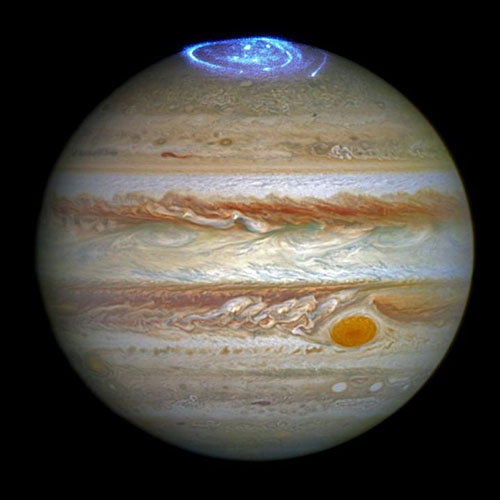
The image of the Northern Lights was taken ahead of the arrival of Nasa's spaceship Juno next week which will spend a year monitoring the largest planet in the Solar System. Jupiter is known for its colorful storms such as the Great Red Spot which swirls constantly in the planet's atmosphere. But it's powerful magnetic field also means it has spectacular light shows at its poles. Just like on Earth, auroras are created when high energy particles enter a planet's atmosphere near its magnetic poles and collide with atoms of gas.'
Auroras and the Magnetosphere of Jupiter APOD - April 6, 2016
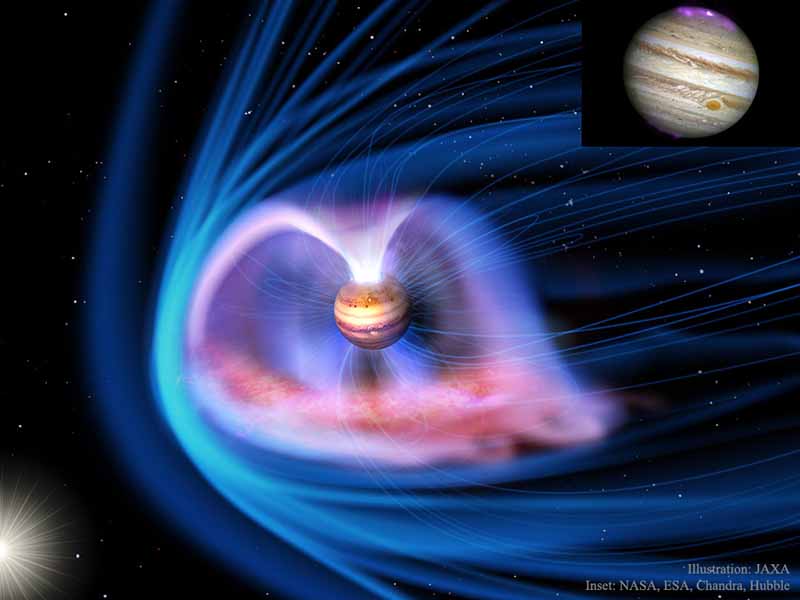
NASA's Juno probe discovered a giant new storm swirling near Jupiter's south pole last month, a few weeks after pulling off a dramatic death-dodging maneuver. Juno spied the newfound maelstrom, which is about as wide as Texas, on Nov. 3, during its most recent close flyby of Jupiter. The storm joins a family of six other cyclones in Jupiter's south polar region, which Juno had spotted on previous passes by the gas giant. (Those encounters also revealed nine cyclones near Jupiter's north pole, by the way.)
'Diamond rain' falls on Saturn and Jupiter BBC - October 14, 2013

Diamonds that are the right size to have been worn by stars of the Silver Screen could rain down on Saturn and Jupiter, US scientists have calculated. New atmospheric data for the gas giants indicates that carbon is abundant in its dazzling crystal form, they say. Lightning storms turn methane into soot (carbon) which as it falls hardens into chunks of graphite and then diamond.
Fireballs Light Up Jupiter Science Daily - September 11, 2010
Amateur astronomers working with professional astronomers have spotted two fireballs lighting up Jupiter's atmosphere this summer, marking the first time Earth-based telescopes have captured relatively small objects burning up in the atmosphere of the giant planet. The two fireballs - which produced bright freckles on Jupiter that were visible through backyard telescopes - occurred on June 3, 2010, and August 20, 2010, respectively.
Jupiter is the fifth planet from the Sun and the largest planet within the Solar System. It is a gas giant with mass one-thousandth that of the Sun but is two and a half times the mass of all the other planets in our Solar System combined. Jupiter is classified as a gas giant along with Saturn, Uranus and Neptune. Together, these four planets are sometimes referred to as the Jovian or outer planets.
The planet was known by astronomers of ancient times and was associated with the mythology and religious beliefs of many cultures. The Romans named the planet after the Roman god Jupiter. When viewed from Earth, Jupiter can reach an apparent magnitude of -2.94, making it on average the third-brightest object in the night sky after the Moon and Venus. (Mars can briefly match Jupiter's brightness at certain points in its orbit.)
Jupiter is primarily composed of hydrogen with a quarter of its mass being helium; it may also have a rocky core of heavier elements. Because of its rapid rotation, Jupiter's shape is that of an oblate spheroid (it possesses a slight but noticeable bulge around the equator). The outer atmosphere is visibly segregated into several bands at different latitudes, resulting in turbulence and storms along their interacting boundaries.
A prominent result is the Great Red Spot, a giant storm that is known to have existed since at least the 17th century when it was first seen by telescope. Surrounding the planet is a faint planetary ring system and a powerful magnetosphere. There are also at least 66 moons, including the four large moons called the Galilean moons that were first discovered by Galileo Galilei in 1610. Ganymede, the largest of these moons, has a diameter greater than that of the planet Mercury.
Jupiter has been explored on several occasions by robotic spacecraft, most notably during the early Pioneer and Voyager flyby missions and later by the Galileo orbiter. The most recent probe to visit Jupiter was the Pluto-bound New Horizons spacecraft in late February 2007. The probe used the gravity from Jupiter to increase its speed. Future targets for exploration in the Jovian system include the possible ice-covered liquid ocean on the moon Europa.
Jupiter has been known since ancient times and is visible to the naked eye in the night sky. In 1610, Galileo Galilei discovered the four largest moons of Jupiter using a telescope, the first observation of moons other than Earth's.
Jupiter is 2.5 times more massive than all the other planets combined, so massive that its barycenter with the Sun actually lies above the Sun's surface (1.068 solar radii from the Sun's center). It is 318 times more massive than Earth, with a diameter 11 times that of Earth, and with a volume 1300 times that of Earth. It has been termed by many a "failed star", even though the comparison would be akin to calling an asteroid "a failed Earth".
As impressive as it is, extrasolar planets have been discovered with much greater masses. However, it is thought to have about as large a diameter as a planet of its composition can, as adding extra mass would only result in further gravitational compression (until ignition occurs). There is no clear-cut definition of what distinguishes a large and massive planet such as Jupiter from a brown dwarf, although the latter possesses rather specific spectral lines, but in any case Jupiter would need to be about seventy times as massive if it were to become a star.
Jupiter also has the fastest rotation rate of any planet within the solar system, making a complete revolution on its axis in slightly less than ten hours, which results in a flattening easily seen through an Earth-based amateur telescope. Its best known feature is probably the Great Red Spot, a storm larger than Earth. The planet is perpetually covered with a layer of clouds.
Jupiter is usually the fourth brightest object in the sky (after the Sun, the Moon and Venus; however at times Mars appears brighter than Jupiter, while at others Jupiter appears brighter than Venus). It has been known since ancient times. Galileo Galilei's discovery, in 1610, of Jupiter's four large moons Io, Europa, Ganymede and Callisto (now known as the Galilean moons) was the first discovery of a celestial motion not apparently centered on the Earth. It was a major point in favor of Copernicus' heliocentric theory of the motions of the planets; Galileo's outspoken support of the Copernican theory got him in trouble with the Inquisition.
Jupiter is composed of a relatively small rocky core, surrounded by metallic hydrogen, surrounded by liquid hydrogen, which is surrounded by gaseous hydrogen. There is no clear boundary or surface between these different phases of hydrogen; the conditions blend smoothly from gas to liquid as one descends.
The atmosphere contains trace amounts of methane, water vapor, ammonia, and "rock". There are also traces of carbon, ethane, hydrogen sulfide, neon, oxygen, phosphine, and sulfur. The outermost layer of the atmosphere contains crystals of frozen ammonia.This atmospheric composition is very close to the composition of the solar nebula. Saturn has a similar composition, but Uranus and Neptune have much less hydrogen and helium.
Jupiter's upper atmosphere undergoes differential rotation, an effect first noticed by Giovanni Cassini (1690). The rotation of Jupiter's polar atmosphere is ~5 minutes longer than that of the equatorial atmosphere. In addition, bands of clouds of different latitudes flow in opposing directions on the prevailing winds. The interactions of these conflicting circulation patterns cause storms and turbulence. Wind speeds of 600 km/h are not uncommon.
A particularly violent storm, about three times Earth's diameter, is known as the Great Red Spot.

The Great Red Spot is a persistent high-pressure region in the atmosphere of Jupiter, producing an anticyclonic storm that is the largest in the Solar System. It is the most recognizable feature on Jupiter, owing to its red-orange color whose origin is still unknown. Located 22 degrees south of Jupiter's equator, it produces wind-speeds up to 432 km/h (268 mph). Observations from 1665 to 1713 are believed to be of the same storm; if this is correct, it has existed for at least 359 years. It was next observed in September 1831, with 60 recorded observations between then and 1878, when continuous observations began.
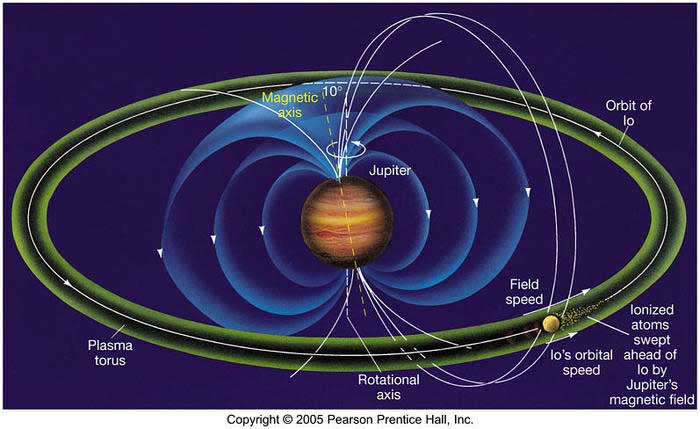
Jupiter has auroras. Like near the Earth, the magnetic field of our Solar System's largest planet compresses when impacted by a gust of charged particles from the Sun. This magnetic compression funnels charged particles towards Jupiter's poles and down into the atmosphere. There, electrons are temporarily excited or knocked away from atmospheric gases, after which, when de-exciting or recombining with atmospheric ions, auroral light is emitted. The featured illustration portrays the magnificent magnetosphere around Jupiter in action. In the inset image released last month, the Earth-orbiting Chandra X-ray Observatory shows unexpectedly powerful X-ray light emitted by Jovian auroras, depicted in false-colored purple. That Chandra inset is superposed over an optical image taken at a different time by the Hubble Space Telescope. This aurora on Jupiter was seen in October 2011, several days after the Sun emitted a powerful Coronal Mass Ejection (CME).
Aurora on Jupiter. Three bright dots are created by magnetic flux tubes that connect to the Jovian moons Io (on the left), Ganymede and Europa on the bottom. In addition, the very bright almost circular region, called the main oval, and the fainter polar aurora can be seen.
Jupiter has a very large and powerful magnetosphere. In fact, if you could see Jupiter's magnetic field from Earth, it would appear five times as large as the full moon in the sky despite being so much farther away. This magnetic field collects a large flux of particle radiation in Jupiter's radiation belts, as well as producing a dramatic gas torus and flux tube associated with Io. Jupiter's magnetosphere is the largest planetary structure in the solar system.
The Pioneer probes confirmed the existence that Jupiter's enormous magnetic field is 10 times stronger than Earth's and contains 20,000 times as much energy. The sensitive instruments aboard found that the Jovian magnetic field's "north" magnetic pole is at the planet's geographic south pole, with the axis of the magnetic field tilted 11 degrees from the Jovian rotation axis and offset from the center of Jupiter in a manner similar to the axis of the Earth's field. The Pioneers measured the bow shock of the Jovian magnetosphere to the width of 26 million kilometres (16 million miles), with the magnetic tail extending beyond Saturn's orbit.
The data showed that the magnetic field fluctuates rapidly in size on the sunward side of Jupiter because of pressure variations in the solar wind, an effect studied in further detail by the two Voyager spacecraft. It was also discovered that streams of high-energy atomic particles are ejected from the Jovian magnetosphere and travel as far as the orbit of the Earth. Energetic protons were found and measured in the Jovian radiation belt and electric currents were detected flowing between Jupiter and some of its moons, particularly Io.

Galilean Moons
There are 95 moons of Jupiter with confirmed orbits as of February 5, 2024. This number does not include a number of meter-sized moonlets thought to be shed from the inner moons, nor hundreds of possible kilometer-sized outer irregular moons that were only briefly captured by telescopes.
All together, Jupiter's moons form a satellite system called the Jovian system. The most massive of the moons are the four Galilean moons: Io, Europa, Ganymede, and Callisto, which were independently discovered in 1610 by Galileo Galilei and Simon Marius and were the first objects found to orbit a body that was neither Earth nor the Sun.
Much more recently, beginning in 1892, dozens of far smaller Jovian moons have been detected and have received the names of lovers (or other sexual partners) or daughters of the Roman god Jupiter or his Greek equivalent Zeus.
The Galilean moons are by far the largest and most massive objects to orbit Jupiter, with the remaining 91 known moons and the rings together comprising just 0.003% of the total orbiting mass.
Of Jupiter's moons, eight are regular satellites with prograde and nearly circular orbits that are not greatly inclined with respect to Jupiter's equatorial plane. The Galilean satellites are nearly spherical in shape due to their planetary mass, and are just massive enough that they would be considered major planets if they were in direct orbit around the Sun.
The other four regular satellites, known as the inner moons, are much smaller and closer to Jupiter; these serve as sources of the dust that makes up Jupiter's rings. The remainder of Jupiter's moons are outer irregular satellites whose prograde and retrograde orbits are much farther from Jupiter and have high inclinations and eccentricities.
The largest of these moons were likely asteroids that were captured from solar orbits by Jupiter before impacts with other small bodies shattered them into many kilometer-sized fragments, forming collisional families of moons sharing similar orbits. Jupiter is expected to have about 100 irregular moons larger than 1 km (0.6 mi) in diameter, plus around 500 more smaller retrograde moons down to diameters of 0.8 km (0.5 mi). Continue reading
NASA launches probe to study if life is possible on icy Jupiter moon Europa PhysOrg - October 14, 2024

Lift-off aboard a powerful SpaceX Falcon Heavy rocket took place shortly after noon with the probe set to reach Jupiter's moon Europa in five and a half years. The mission will allow the US space agency to uncover new details about Europa, which scientists believe could hold an ocean beneath its icy surface.
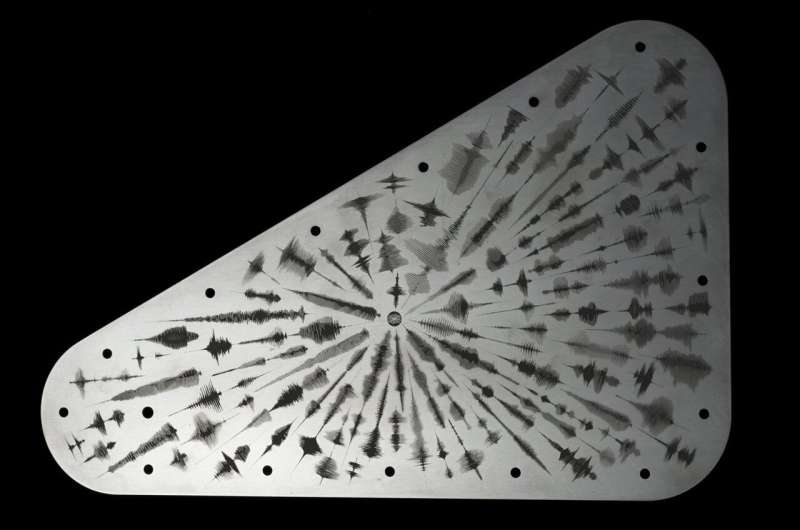
NASA unveils design for message heading to Jupiter's moon Europa PhysOrg - March 10, 2024
New Revelations Dash Hopes For Alien Life on Jupiter's Icy Moon Europa Science Alert - March 9, 2024
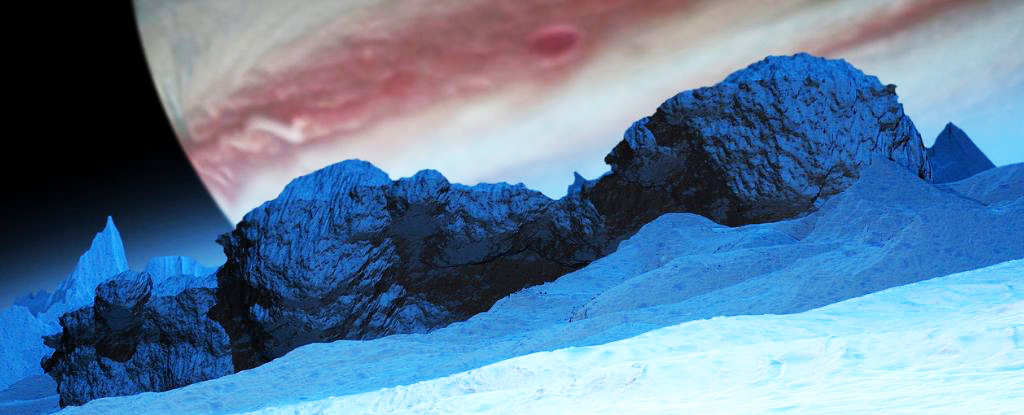
Stunning New Pics of Jupiter's Moon Io Snapped From Earth's Surface Live Science - June 5, 2024

A Newborn Jupiter Could Have Been Bright Enough to Bake Its Moons Science Alert - March 30, 2023
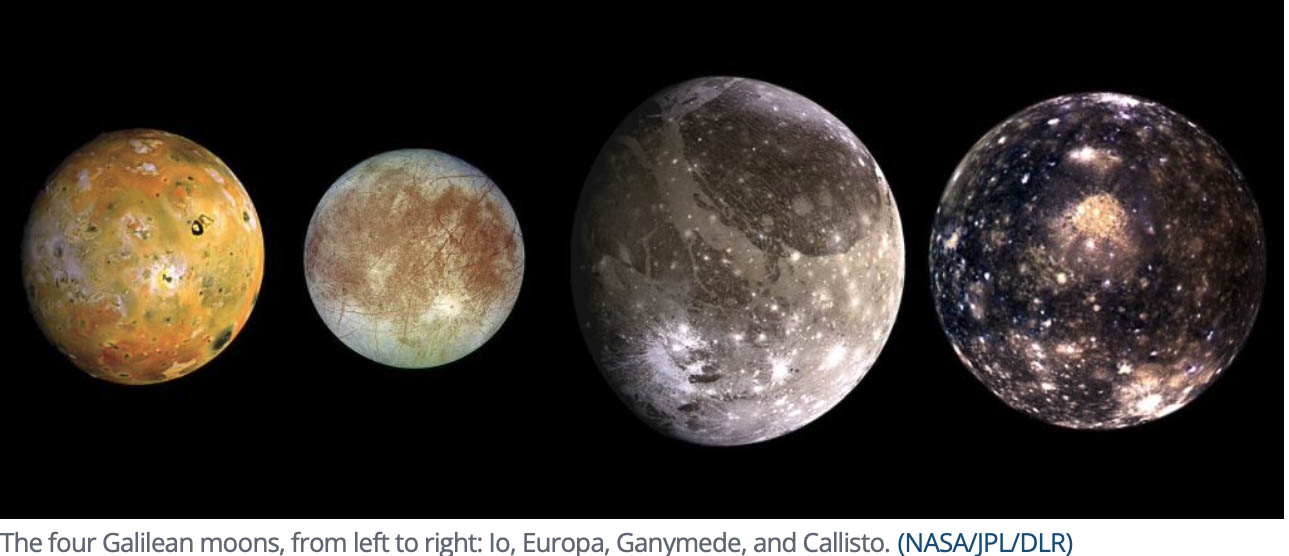
Jupiter's Largest Moons All Have Aurorae That Glow Deep Red And 15x Brighter Than Ours Science Alert - February 21, 2023
Like Earth, these dazzling displays result from charged solar particles interacting with Jupiter's magnetic field and atmosphere.
Stunning New NASA Pic Reveals Lava Glowing Red Hot on Jupiter's Moon Io Science Alert - December 16, 2022
Io is home to hundreds of volcanoes, NASA has found. Surprisingly, scientists found more volcanic spots in the polar region than in the planet's equatorial region.
Underwater snow gives clues about Europa's icy shell PhysOrg - August 15, 2022
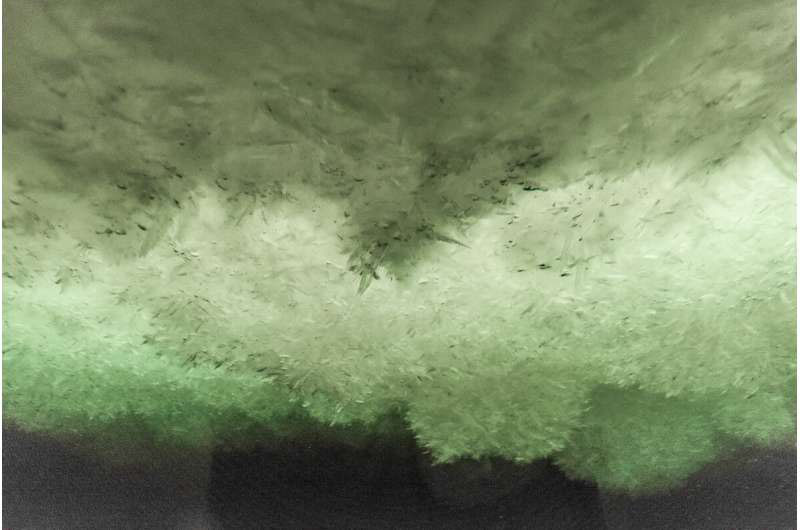
The shell of Jupiter's famous ice moon may be formed, in part, by pure underwater snow that floats up instead of falling down.
Water vapor detected on Jupiter's ocean moon Europa Space.com - October 18, 2021
Hubble had previously detected water vapor on Europa - in apparent plumes that arise sporadically and temporarily extend perhaps 120 miles (200 kilometers) into space from the moon's icy shell, which overlies a huge, buried ocean of liquid water. But this new finding is something quite different.
Hubble finds first evidence of water vapor on Jupiter's moon Ganymede PhysOrg - July 26, 2021
Hubble spots possible water plumes erupting on Jupiter's moon Europa PhysOrg - September 26, 2016

Astronomers using NASA's Hubble Space Telescope have imaged what may be water vapor plumes erupting off the surface of Jupiter's moon Europa. This finding bolsters other Hubble observations suggesting the icy moon erupts with high-altitude water vapor plumes. The observation increases the possibility that missions to Europa may be able to sample Europa's ocean without having to drill through miles of ice.
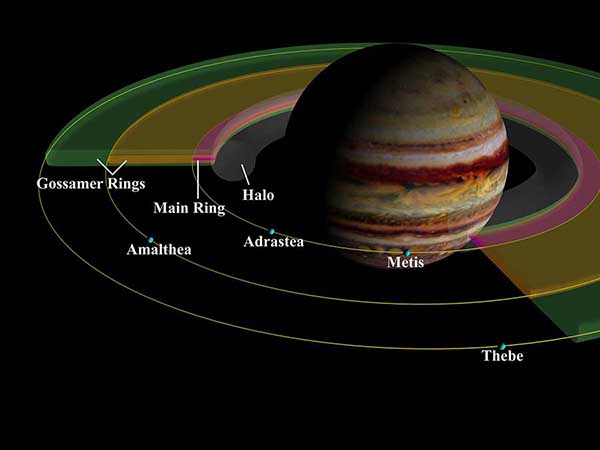
The planet Jupiter has a system of rings, known as the rings of Jupiter or the Jovian ring system. It was the third ring system to be discovered in the Solar System, after those of Saturn and Uranus. It was first observed in 1979 by the Voyager 1 space probe and thoroughly investigated in the 1990s by the Galileo orbiter. It has also been observed by the Hubble Space Telescope and from Earth for the past 23 years. Ground-based observations of the rings require the largest available telescopes.
The Jovian ring system is faint and consists mainly of dust. It has four main components: a thick inner torus of particles known as the "halo ring"; a relatively bright, exceptionally thin "main ring"; and two wide, thick and faint outer "gossamer rings", named for the moons of whose material they are composed: Amalthea and Thebe.
The main and halo rings consist of dust ejected from the moons Metis, Adrastea and other unobserved parent bodies as the result of high-velocity impacts. High-resolution images obtained in February and March 2007 by the New Horizons spacecraft revealed a rich fine structure in the main ring.
In visible and near-infrared light, the rings have a reddish color, except the halo ring, which is neutral or blue in color. The size of the dust in the rings varies, but the cross-sectional area is greatest for nonspherical particles of radius about 15 um in all rings except the halo. The halo ring is probably dominated by submicrometre dust. Continue reading

In Roman mythology, Jupiter held the same role as Zeus in the Greek pantheon. He was called Jupiter Optimus Maximus Soter (Jupiter Best, Greatest, Saviour) as the patron deity of the Roman state, in charge of laws and social order. He was the chief god of the Capitoline Triad, with Juno and Minerva.
Jupiter was known as the god of justice. He was named king of the gods in the special meeting that followed his overthrow of the god Saturn (Cronus in Greek mythology) and the Titans. In the council of the gods that followed Saturn's overthrow, Jupiter was crowned Lord of Heaven and Earth and of all the gods. Jupiter granted Neptune dominion over the Sea, and his other brother Pluto dominion over the underworld.
Jupiter, as Zeus, Z, in Greek mythology is the king of heaven and Earth and of all the Olympian gods. He is sometimes depicted throwing zig-zig lightning bolts to remind humans that reality is created by electromagnetic energy which moves the magic and mystery of the Simulation through which we experience.
Jupiter is a vocative compound derived from archaic Latin Iovis and pater (Latin for father), this was also used as the nominative case. Jove is an English formation based on Iov-, the stem of oblique cases of the Latin name. Its Vedic equivalent is Dyaus Pita. The name of the god was also adopted as the name of the planet Jupiter, and was the original namesake of the weekday that would come to be known in English as Thursday (the etymological root can be seen in various Romance languages, including (accusative Iovem, genitive Iovis, dative Iovi and ablative Iove - an irregular declension). Linguistic studies identify his name as deriving from the Indo-European compound "O Father God", the Indo-European deity from whom also derive the Germanic Tiwaz (after whom Tuesday was named), the Greek Zeus, and the French jeudi, Castilian jueves, Italian giovedô and Catalan dijous, all from Latin Iovis Dies, whereas English takes his Norse equivalent, Thor).
The largest temple in Rome was that of Jupiter Optimus Maximus on the Capitoline Hill. Here he was worshipped alongside Juno and Minerva, forming the Capitoline Triad. Jupiter was also worshipped at Capitoline Hill in the form of a stone, known as Juppiter Lapis or the Jupiter Stone, which was sworn upon as an oath stone. Temples to Jupiter Optimus Maximus or the Capitoline Triad as a whole were commonly built by the Romans at the center of new cities in their colonies.
Jupiter is the method each of us has for dealing with the laws of life, our Saturn or limitations. The Hindu word for Jupiter is Guru and this planet indicates our particular Dharma, the way we can solve the problems that confront us. Thus Jupiter has to do with our vocation, the way in which we can be successful. Jupiter is the light or path. The largest planet in the solar system, Jupiter represents the principles of growth and expansion.
Sagittarius is a mutable fire sign ruled by Jupiter.
In Roman mythology, Jupiter held the same role as Zeus in the Greek pantheon. Zeus is Z aka Zoroaster which takes us to the Anunnaki, Thoth, and others including Jesus depending on which storyline (myth) you are referencing. One soul played all the roles.
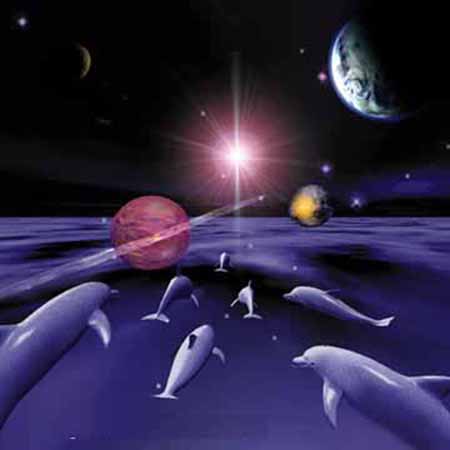
One pseudoscience theory states that life on Europa is connected
to dolphins on planet Earth, communication via telepathy.
One of my earliest remote views to outer space instantly took me to Jupiter - then a visual of Europa - one of Jupiter's 95 moons (satellites) - as if there was something I was connected to though I never found out what it was.
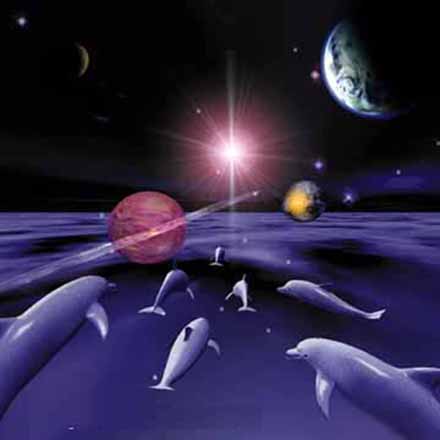
One of my earliest posts on Crystalinks - circa 1995 - was about channelers who believe there is an alien connection between Dolphins and Jupiter's moons Europa and Io. Decades later we still find a continued fascination with Europa as NASA Mission Launches to Probe For Alien Life on Jupiter's Ocean Moon Europa.